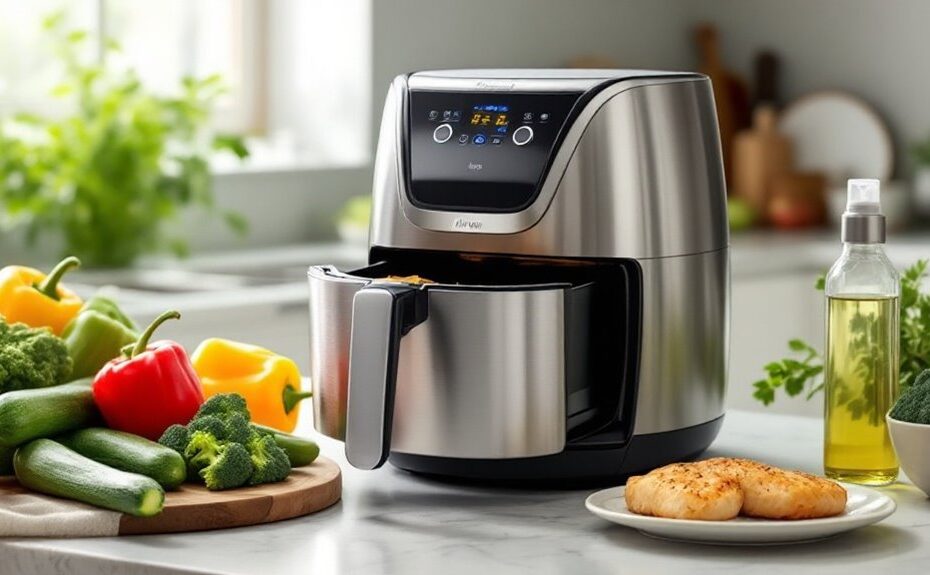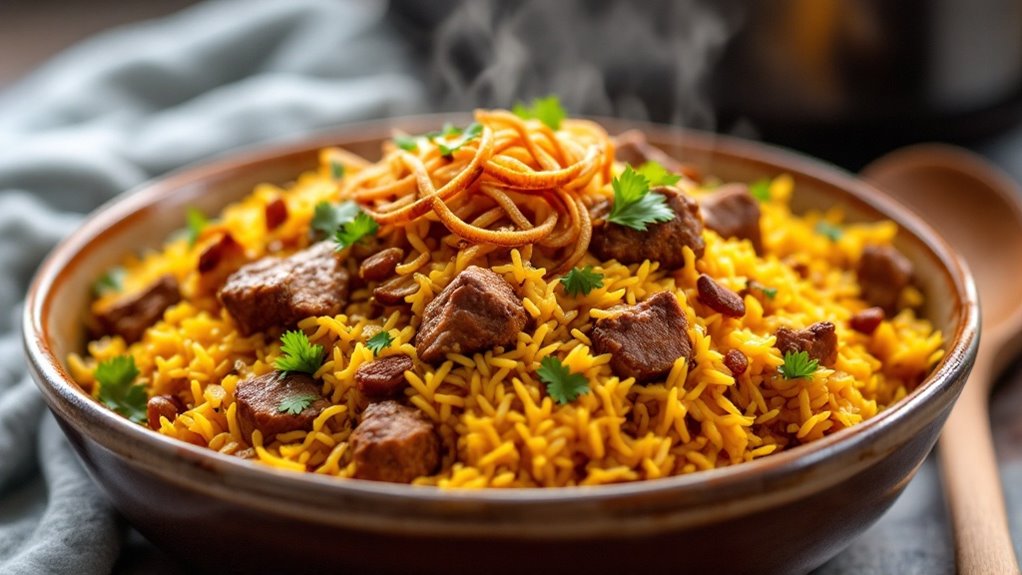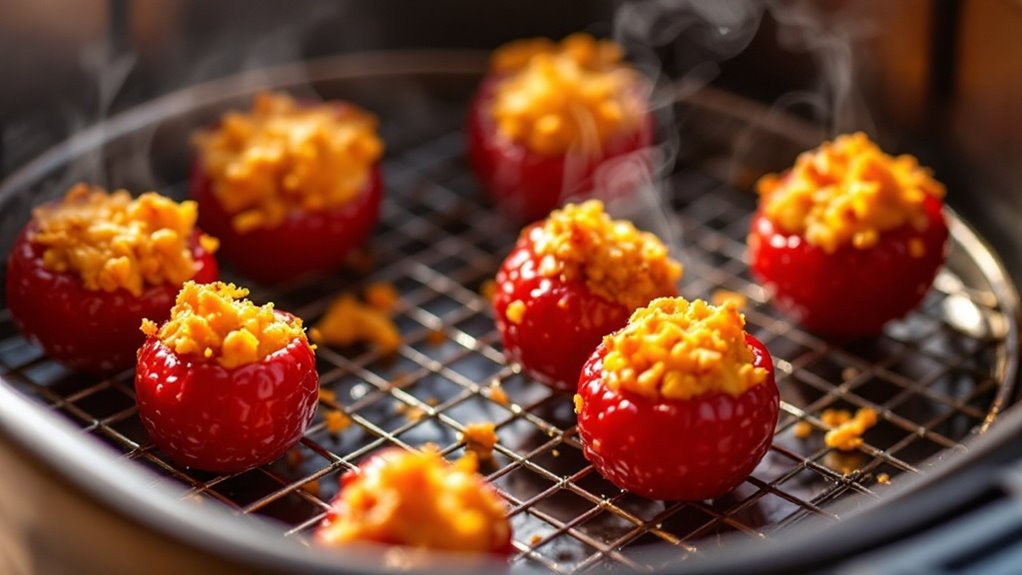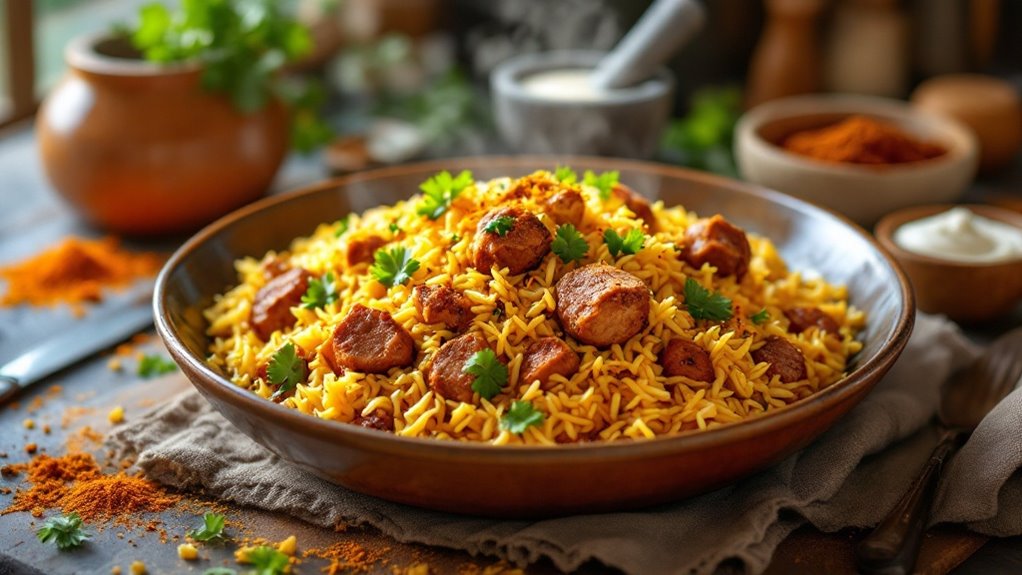Using an air fryer for a low-fat diet starts with selecting the right ingredients—lean proteins, fresh veggies, and whole grains. You'll want to preheat the air fryer to guarantee even cooking and that perfect crispiness without excess oil. Swap out traditional frying methods by using minimal oil or alternatives like broth or citrus juice. Seasoning with herbs and spices can elevate flavor without adding fat, but timing is key—adjust cooking times based on what you're preparing. The real secret lies in how you maintain your air fryer to keep it performing at its best. Curious about the details? Let's explore further.
Key Takeaways
- Choose lean proteins, fresh vegetables, and whole grains to minimize fat content in air fryer meals.
- Preheat the air fryer to 350°F–400°F for even cooking and crispier results without excess oil.
- Use minimal oil or oil-free substitutes like broth or citrus juice to reduce fat while maintaining moisture.
- Season with herbs, spices, or healthy marinades for flavor without adding unnecessary fats.
- Adjust cooking times based on food type and monitor with a thermometer for perfectly cooked, low-fat meals.
Choose Low-Fat Ingredients for Air Frying
When selecting ingredients for air frying, opt for lean proteins, vegetables, and whole grains to keep your meals low in fat. Focus on low-fat proteins like skinless chicken breast, turkey, or fish, which cook well in an air fryer and retain moisture without added oils. Lean meat options such as pork tenderloin or sirloin steak are also excellent choices, as they're naturally lower in saturated fats. Pair these with vegetables like broccoli, zucchini, or bell peppers, which crisp up beautifully and add nutrients. Whole grains, such as quinoa or whole-wheat breadcrumbs, can be used for coatings or sides. Avoid high-fat ingredients like fatty cuts of meat or heavily processed foods, as they counteract the air fryer's health benefits. Prioritize fresh, whole ingredients for ideal results.
Preheat the Air Fryer for Optimal Results
To achieve the best results with your air fryer, preheating it is essential, as it guarantees even cooking and a crispier texture. Set the preheat temperature to the level specified in your recipe or the air fryer manual, typically between 350°F and 400°F. Most air fryers require a preheat duration of 3 to 5 minutes, but this can vary depending on the model and the food you're preparing. Preheating makes certain the cooking chamber reaches the ideal temperature before you add your ingredients, which helps reduce cooking time and prevents uneven results. Skipping this step may lead to soggy or undercooked food. Always check your air fryer's instructions for specific preheat recommendations, as some models may have unique settings or requirements.
Use Minimal Oil or Oil Substitutes
To reduce fat intake, choose healthy oil alternatives like avocado or olive oil, which contain beneficial monounsaturated fats. Apply oil sparingly by using a spray bottle or brush to lightly coat your food, ensuring even distribution without excess. This approach maintains crispiness while keeping your meal low in fat.
Choose Healthy Oil Alternatives
Opting for healthy oil alternatives can substantially reduce fat intake while still delivering flavorful results in your air fryer. For oil-free cooking, consider using broth, vinegar, or citrus juice to add moisture and flavor without added fats. When you need a light coating, use a spray oil application with heart-healthy options like avocado or olive oil, which contain beneficial monounsaturated fats. These oils withstand high heat better than many alternatives, making them ideal for air frying. Avoid heavily processed oils high in saturated or trans fats, as they can undermine your low-fat goals. By choosing minimally processed, nutrient-dense oils or oil substitutes, you maintain the crisp texture and taste of air-fried foods while keeping fat content in check. This approach supports both flavor and health.
Apply Oil Sparingly
When using an air fryer for a low-fat diet, applying oil sparingly guarantees you achieve the desired crispness without excess fat. Use oil application techniques like a spray bottle to evenly distribute a thin layer of oil over your food. This method secures minimal oil usage while enhancing texture. Alternatively, lightly brush oil onto food using a silicone brush for precise control. Research shows that air fryers require notably less oil than traditional frying methods, making them ideal for low-fat cooking. Avoid drenching food in oil, as it can counteract the health benefits of air frying. Opt for oil substitutes like broth or lemon juice for added moisture without added fat. By mastering these techniques, you'll maintain flavor and texture while adhering to your dietary goals.
Experiment With Seasonings and Marinades
Enhance your meals with bold seasonings like herbs, spices, and citrus zest to add flavor without relying on added fats. Opt for healthy marinade alternatives such as vinegar, yogurt, or citrus juices, which tenderize and infuse flavor while keeping fat content low. Experimenting with these options can elevate your air-fried dishes while supporting your low-fat diet goals.
Flavor Without Added Fat
While reducing fat in your diet, you can still achieve bold flavors by experimenting with seasonings and marinades. Flavor enhancement in fat-free cooking relies on herbs, spices, and acidic ingredients like citrus or vinegar. Use garlic, paprika, cumin, or turmeric to add depth without extra calories. Dry rubs with chili powder, black pepper, and smoked paprika create a crust that mimics the richness of fried foods. For moisture and tang, marinate proteins in lemon juice or balsamic vinegar before air frying. Fresh herbs like cilantro, basil, or rosemary infuse dishes with vibrant aromas. Avoid pre-packaged seasoning mixes high in sodium; instead, blend your own for better control. By focusing on these techniques, you'll enjoy satisfying meals without compromising your low-fat goals.
Healthy Marinade Alternatives
To create healthy marinade alternatives, focus on ingredients that add flavor without excess fat or calories. Use herb-infused marinades by combining fresh or dried herbs like rosemary, thyme, or cilantro with garlic, vinegar, and a splash of olive oil. These combinations enhance taste while keeping fat content low. Citrus-based marinades are another excellent option; lemon, lime, or orange juice paired with zest, garlic, and spices tenderizes proteins and adds brightness without added fats. Avoid sugary or high-sodium store-bought marinades, as they can undermine your low-fat goals. Experiment with spices like paprika, cumin, or chili powder to boost flavor profiles. Marinate proteins for at least 30 minutes to allow flavors to penetrate, ensuring a delicious, low-fat result when air-fried.
Adjust Cooking Times for Different Foods
Since different foods cook at varying rates in an air fryer, adjusting cooking times is essential to achieve ideal results. Cooking time variations depend on factors like food density, moisture content, and thickness. For example, vegetables like zucchini or broccoli cook faster than denser items like sweet potatoes or chicken breasts. Start by preheating your air fryer to guarantee consistent results, then monitor food temperature adjustments using a meat thermometer for proteins. Thin cuts or smaller portions may require less time, while larger or frozen items often need extended cooking. Refer to your air fryer's manual for general guidelines, but always check for doneness halfway through to avoid overcooking. Experiment with shorter intervals initially, as air fryers cook faster than traditional methods, making certain low-fat meals remain tender and flavorful.
Clean and Maintain Your Air Fryer Regularly
Regular cleaning and maintenance of your air fryer make certain it performs efficiently and extends its lifespan. Establish a consistent cleaning frequency, ideally after every use, to prevent grease buildup and food residue. Unplug the appliance, let it cool, and wipe the exterior with a damp cloth. Remove the basket and tray, then wash them with warm, soapy water or place them in the dishwasher if they're dishwasher-safe. Use a non-abrasive sponge to avoid scratching surfaces. For maintenance tips, inspect the heating element periodically for debris and clean it gently with a soft brush. Avoid submerging the base in water. Dry all components thoroughly before reassembling to prevent moisture damage. Proper care makes sure your air fryer remains a reliable tool for low-fat cooking.
Disclosure: As an Amazon Associate, I earn from qualifying purchases.



